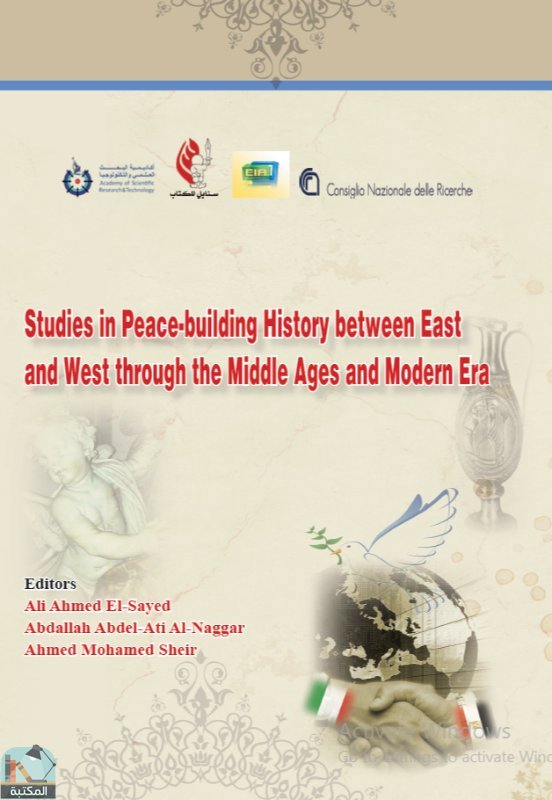📘 ❞ STUDIES IN PEACE-BUILDING HISTORY BETWEEN EAST AND WEST THROUGH THE MIDDLE AGES AND MODERN ERA ❝ كتاب اصدار 2019
- 📖 كتاب ❞ STUDIES IN PEACE-BUILDING HISTORY BETWEEN EAST AND WEST THROUGH THE MIDDLE AGES AND MODERN ERA ❝ ــ مجموعة من المؤلفين 📖
█ _ مجموعة من المؤلفين 2019 حصريا كتاب ❞ STUDIES IN PEACE BUILDING HISTORY BETWEEN EAST AND WEST THROUGH THE MIDDLE AGES MODERN ERA ❝ عن جميع الحقوق محفوظة للمؤلف 2024 ERA: FOREWORD The human world is a multidimensional where people from different cultures and religions have lived together We live in one which has multitude of dimensions The phrase “between East West” meanings Rome, Cairo, Budapest In geographical sense “the East” can refer to the eastern coast Mediterranean Sea (the Levant), it Arab world, or Far depending upon context From Cairo “East” mostly considered as synonym even if Maghreb countries are located west Egypt Central European point view means and, at same time, Moscow oriented territories, while denotes Euro Atlantic region These alternatives historical reasons Looking West civilizational aspect, differences between cultures, their connecting points, coexistence earlier conflicts, too There been interaction Christianity Islam since Middle Ages, including Iberian Peninsula crusades directed equalization started modern era, this process continued into present This volume presents histories peaceful various people, empires, Ages end 20th century authors examined contact points Byzantine Empire, through Trebizond Empire period Seljuk Sultanate history already elaborated by well historians presented studies also insights Egyptian Copts Muslims 1882 1952 The relations Christians were simultaneously marked alternating periods war peace there several instances coexistence, volume, too, would like contribute According historian Edward Hallett Carr, begins when think about passing time form series events they involved own will, being able influence them consciously, rather than thinking categories natural phenomena, such cycle seasons life expectancy History nothing else man’s struggle his reason, order understand environment act (What History? Pengium Books Ltd, Harmondsworth, Middlesex, England, 1986) János Sáringer مجاناً PDF اونلاين

كتاب
STUDIES IN PEACE-BUILDING HISTORY BETWEEN EAST AND WEST THROUGH THE MIDDLE AGES AND MODERN ERA
صدر 2019م
كتاب
STUDIES IN PEACE-BUILDING HISTORY BETWEEN EAST AND WEST THROUGH THE MIDDLE AGES AND MODERN ERA
صدر 2019م- مساهمة من: د. عبدالله عبدالعاطي النجار
( الأربعاء 2 أغسطس 2023 ( 9:54 مساءً )) - تبليغ عن سوء استخدام

FOREWORD
The human world is a multidimensional world where people from different cultures and religions have lived together. We live in one world which has a multitude of dimensions. The phrase “between East and West” has different meanings in Rome, in Cairo, and in Budapest. In a geographical sense “the East” can refer to the eastern coast of the Mediterranean Sea (the Levant), it can refer to the Arab world, or it can refer to the Far East depending upon context. From Cairo “East” is mostly considered as the synonym of the Arab world, even if the Maghreb countries are located to the west of Egypt. From a Central European point of view “the East” means the Arab world, and, at the same time, the Moscow-oriented territories, while “the West” denotes the Euro-Atlantic region. These alternatives have historical reasons. Looking at the phrase East and West from a civilizational aspect, it can refer to the differences between cultures, their connecting points, their coexistence and earlier conflicts, too. There has been interaction between Christianity and Islam since the Middle Ages, including the Iberian Peninsula and the crusades directed at the Middle East. The equalization between East and West started in the modern era, and this process has continued into the present.
This volume presents histories of peaceful coexistence between various people, empires, cultures and religions from the Middle Ages to the end of the 20th century. The authors examined the contact points of different cultures from the Byzantine Empire, through the Trebizond Empire period and into the Seljuk Sultanate. The history of the crusades has already been elaborated upon by European as well as Arab historians and is presented in one of the studies of in this volume. We also present insights into the peaceful coexistence between Egyptian Copts and Muslims in the period from 1882 to 1952.
The relations between Christians and Muslims were simultaneously marked by the alternating periods of war and peace. In history there are several instances of peaceful coexistence, to which the present volume, too, would like to contribute. According to the historian Edward Hallett Carr, history begins when people think about the passing of time in the form of series of events in which they are involved of their own will, being able to influence them consciously, rather than thinking in categories of natural phenomena, such as the cycle of seasons or life expectancy. History is nothing else than the man’s struggle by means of his reason, in order to understand his environment and to act upon it. (What is History? Pengium Books Ltd, Harmondsworth, Middlesex, England, 1986)
János Sáringer
أحمد محمد شعير
#10K
0 مشاهدة هذا اليوم#66K
9 مشاهدة هذا الشهر#117K
460 إجمالي المشاهدات- 🎁 كن أول كاتب اقتباس في هذه الصفحة واحصل على هديّة 15 من النقاط فوراً 🎁
